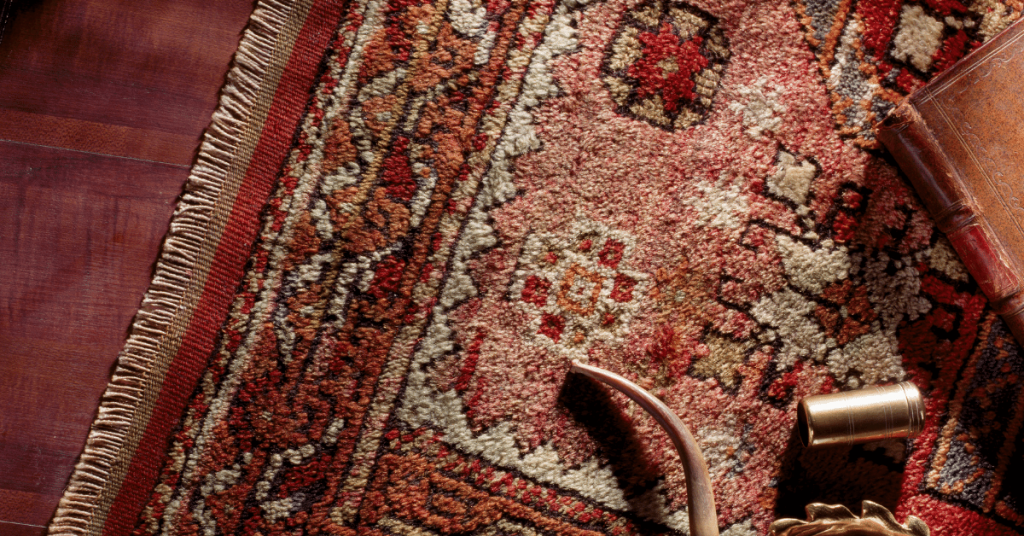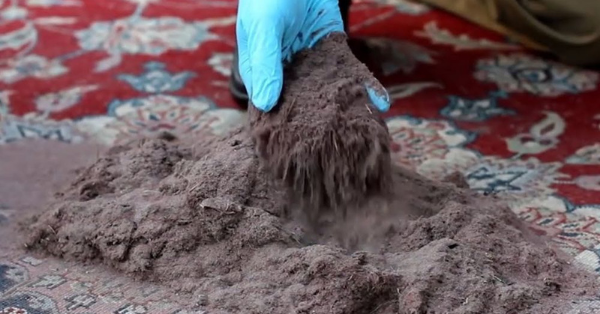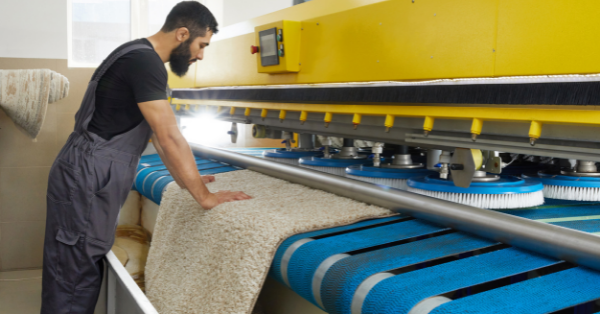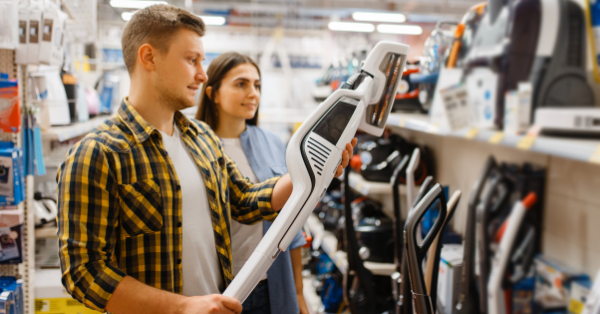If you’re reading this post, you probably own at least one persian rug. Congratulations! Persian rugs are beautiful, they add a lot of style to a home and can (usually do) increase their value in the future.
However, they must be in mint condition. And that means cleaing the rug often so that it doesn’t lose value.
Yes… you could take it to a professional cleaner. As a matter of fact, we’ll discuss later in this post when you should (if you want to go directly to that part, click here). But that can be very expensive.
And if you can clean your persian rug yourself, why not?

Difference between a persian rug and an oriental rug
Although this might be obvious… I still have to say it: This cleaning guide is meant for persian rugs and persian rugs only.
If you’re interested in cleaning any other type of rug, we probably have specific guides for those rugs (jute, wool, etc.) Or you might be interested in checking our Ultimate Rug Cleaning Guide, that covers the general guidelines for all types of rugs.
But… What about oriental rugs? Will this guide help you clean an oriental rug?
Yes!
But! Just to be clear… persian rugs are slightly different.
Historically, persian rugs come only from certain places in modern day Iran and oriental rugs come from many different places (like China, Turkey, Tibet, India, Egypt). From a manufacturing point of view, the knots used on Oriental Rugs are symmetrical Ghiordes knots and on Persian rugs asymmetrical Senneh knots.

And from a cleaning point of view (which is the one that matters) persian rugs are only hand washed. That’s why they’re considered softer overall than oriental rugs and why they’re usually more valueable to collectors.
So… in theory, persian rugs can only be hand washed (while oriental rugs can be machine washed and hand washed). So… in this post we’ll only consider natural and hand washing techniques for the most part. We will be using a vacuum cleaner, but that’s about it.
How often should you clean your persian rug?
If you don’t clean your persian rug often enough, it could (and will) lead to the accumulation of dirt. And the moisture that the dirt contains could ruin the carpet and it’s colors in the future.

If you clean your persian rug too often, you can wear the fibers out. And, although this in quite uncommon, it could completely ruin your rug.
We need to find the middle ground.
But don’t worry! It’s really not that difficult. The average US household should have their persian rugs vacuumed at least once a week (according to the IICRC). This could of course increase if you have pets or children home or the placement of the rug. But if you vacuum at least every other day you should be fine.
What really matters is how many times you deep clean your rug. If the persian rug is in perfect condition and you vacuum it frequently, you should deep clean your carpet between once and twice a year. Either way, you should be fine.
When should you call a professional?
But… does it have to be cleaned by a professional? or can you deep clean it yourself?
I honestly think that deep cleaning your carpet at home can be as effective as a professional cleaning company. This being said… that’s usually not the case.
Professionals have the equipment, time and experience to clean rugs that are extremely dirty. They can sometimes bring back to live rugs that would’ve otherwise been thrown away.

If a persian rug is vacuumed regularly, and has been deep cleaned when it had to be deep cleaned, then you can keep cleaning it at home. But if you haven’t cleaned it for over a year I would recommend hiring a professional. You can start cleaning it yourself after that!
Step by Step: Spot Clean persian rug at home
Don’t you hate it when your rug get’s stained? Hopefully you won’t have to come back to this guide very often!
Persian rugs are very delicate, which is why we can’t apply the same products as the ones we could use (for example) to clean an ordinary home carpet.
But if you follow the instructions carefully, you’ll probably be able to clean almost every stain your rug gets.
Step 1: Create the detergent and the vinegar solutions
The first thing we’re going to do is get everything ready. In order to clean the stain we’re going to be using 2 DIY solutions. We’re going to be using 2 solutions because we don’t know what type of stain we’re dealing with.
Since we’re using both solutions, we can make sure that we’ll clean as many stains as possible.
These are the two solutions that we’ll be making: (they’re super simple!):
1. Detergent solution. Mix 1 tablespoon of detergent and 1/2 cup of warm water. Stir until it gets bubbly.
1. Vinegar solution. Mix 1 tablespoon of white vinegar (any other vinegar might ruin your rug) and 1/2 cup of warm water.
Step 2: Apply the detergent solution
The first thing we’re going to do is apply the detergent solution to the stain. In order to do so, we’re going to take a white towel, dip it into the detergent solution and blot the stain. Please don’t scrub! Or else you might spread the stain or force it to go deeper into the rug’s fibers. And we don’t want that to happen.
CAUTION!
Although highly unlikely, some detergents could be harmful to your rugs color. Please try the detergent mix in a tiny spot before applying it on top of the stain. That way you’ll make sure that it’s save to use.
Once that’s done, we’re going to blot the stain with water. We want to remove as much of the detergent solution as possible before continuing with the next step.
Step 3: Apply the vinegar solution
We’re now going to repeat exactly the same thing we did before, but with the vinegar solution. Remember! You have to blot, not scrub.
Don’t skip this step even if the detergent mix managed to remove all the stains. The vinegar will help remove the odor too!
Repeat steps 2 and 3 until the stain is completely gone!
Step 4: Soak in cold water
Once the stain is gone, you have to make sure that the vinegar and detergent solutions are completely off the rug.
In order to do so, soak the stain in cold water. Blot out the excess of water with a clean towel.
Step 5: Allow it to dry
And that’s it! Allow it to dry naturally. If you apply artificial heat you could burn the rug. And if (for whatever reason) part of the stain is still in the rug, the heat will make it way more difficult to remove in the future.
Allow the rug to dry naturally and enjoy!
Step by Step: Deep Clean persian rug at home
It’s now time to learn how to deep clean your rug the right way. We’re going to describe the closest thing to the traditional method as we possibly can.
This method has been used for thousands of years and it’s responsible for giving persian rug’s such an amazing reputation.
Step 1: Shake the excess dust
The first thing we’re going to do is take our carpet outside. We want to shake it out until to get as much dirt of the carpet as possible. You might need help if it’s a big rug!
The biggest mistake people make is to quit too soon. As a rule of thumb, when you feel like you could stop… that probably means you’re half way through. Seriously! We’re not just shaking the rug so that the dirt falls off, we’re shaking it so that it loosens up a little bit and it’s easier to remove in the next couple of steps.
PRO-TIP
SUNNY DAYS ARE BETTER
Sunny days are usually better to do this because you’ll be able to see the dirt coming out easily. If it’s cloudy, you’ll want to quit sooner because you’ll probably think that what you’re doing isn’t helping a lot.
Step 2: Vacuum each side of the rug
The second thing we’re going to do is take our rug to a clean space. And we’re going to vacuum both sides of the rug!
You can’t get this step wrong. Unless you don’t have a good vacuum cleaner. As it happens with most electronics, vacuum cleaners lose power after a couple of years. And although that might be ok for general use, it would be better to have a good and powerful vacuum cleaner to clean your persian rug.
If you’re in the market for a new vacuum cleaner, check our post on the best vacuum cleaners of 2022. We test and independently review the best vacuum cleaners in the market!

Vacuum both sides thoroughly! Don’t be afraid to go over and over the same area again.
Step 3: Wet the rug
The third thing we’re goint to do is place the rug in a clear area (a porch or a garage are usually best) and get the rug wet. Use cold water (unless it’s so cold outside that it could cause the water to freeze).
You don’t have to get it completely under water (like some professionals do on youtube videos). Just get it soaking wet. That’s it.
Step 4: Clean the carpet using an specific solution
We’re going to be using a specific solution to clean persian rugs. You can basically use any rug shampoo, but make sure that it can be used to clean persian rugs.
I would recommend using this one:
[amazon link=”B0006B0RAQ” title=”Aqua Clean Concentrate”/]
[amazon box=”B0006B0RAQ”]
Follow the manufacturer’s instructions carefully! Most of the time you have to mix 3 table spoons of rug shampoo with a gallon of water. But simply follow what the manufacturer recommends.
CAUTION!
TRY THE SOLUTION ON AN UNNOTICEABLE AREA FIRST!
Some rug shampoos cointain bleach or hydrogen peroxide. Those ingredients can cause your persian rug’s colors to run. Try the solution on an inconspicuous area of the rug before using the solution to clean it completely.
Once you know that the solution isn’t going to cause any dye transfer, clean the rug with a soft brush.
WARNING!
DON’T USE STEAM CARPET CLEANING MACHINES!
In this blog we’ve recommended steam carpet cleaning machines a lot. We think it’s the wisest investment a carpet owner can make (check the best carpet steam cleaners of 2022. But please! Don’t use those machines on your persian rug. You WILL ruin it in almost every scenario.
Step 5: Soak in water and let dry naturally
Once you’ve completely cleaned your rug, it’s time to rinse the rug with fresh water. And let it dry naturally!
This might take a while depending on where you live and how warm it is. But if you apply heat to the rug a couple of bad things could happen:
1. You could burn your rug. Unlikely you may think. But I’ve seen it happen many times.
2. You can dry the top third of the rugs fibers, but the bottom 2/3rds will remain wet. And that’s the perfect environment for mold to grow. We did a post on the different types of mold you can find at your own home. Trust me, you don’t want any of them.
If it’s in the winter, 70º Farenheit is the best temperature for a persian rug to dry. And in the summer… the same! That means that you might have to turn on the air conditioning. This will help the rug dry quicker because it will remove the moisture in the air. And it’s moisture (not temperature) that basically prevents the rug from drying fast.
Step 6: Vacuum again
Once your rug is dry, you have to vacuum it again! And vacuum thoroughly!
Why?
Because of a process called “Wicking”. While the moisture is evaporating, the dirt and soil that remained on the very bottom layer of the rug (where not even water or shampoo can get it out) climb up the fibers and stay on top once it’s completely dry.
So, you’ll have to vacuum again!
PRO TIP
Wicking is the reason why many professional rug cleaners repeat the clean & dry process multiple times. It’s a very natural (and helpful) way of removing rugs that haven’t been cleaned for years.
Conclusion
And that’s it! You know everything there is to know about how to clean spots on your persian rug and how to deep clean your persian rug.
Persian rugs are amazing. They really are. I hope you liked this guide.
Have a great day you guys!
